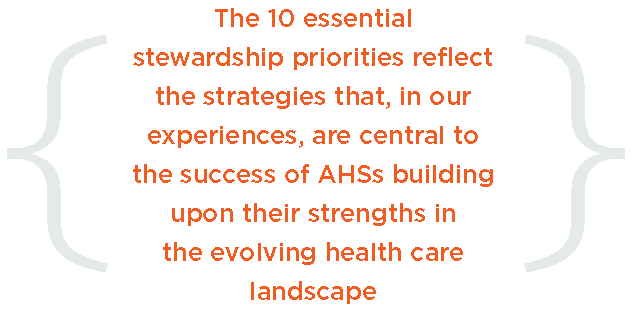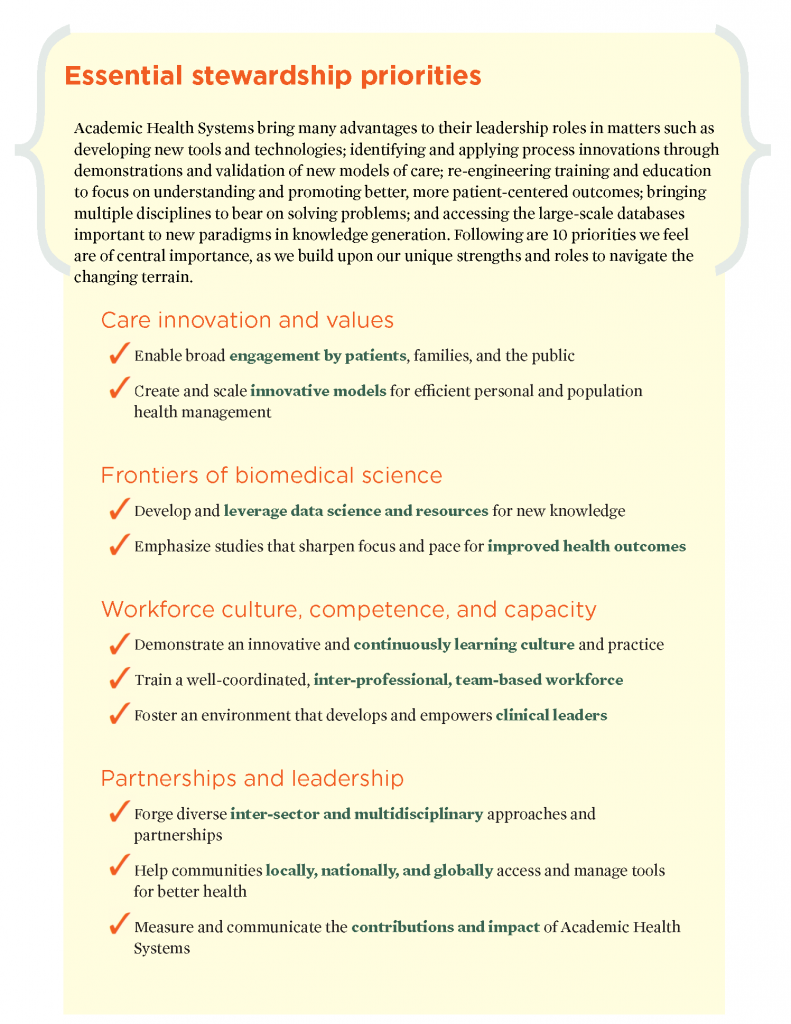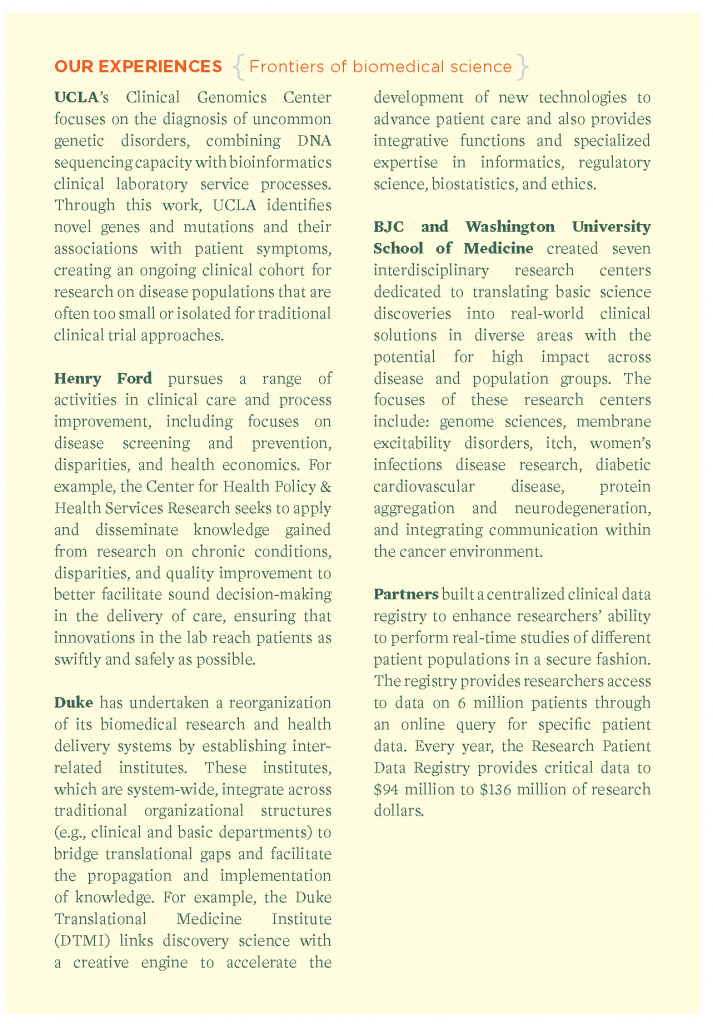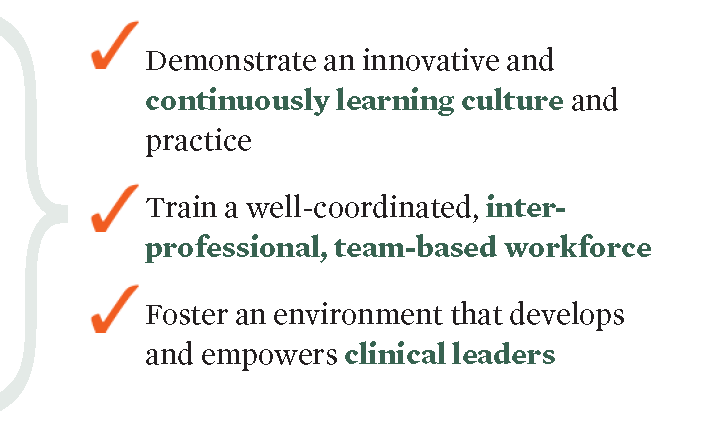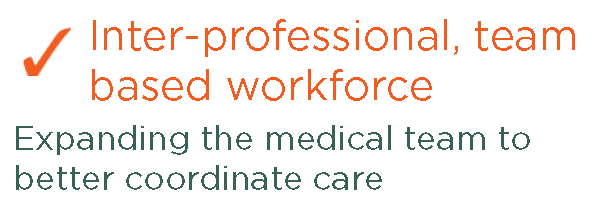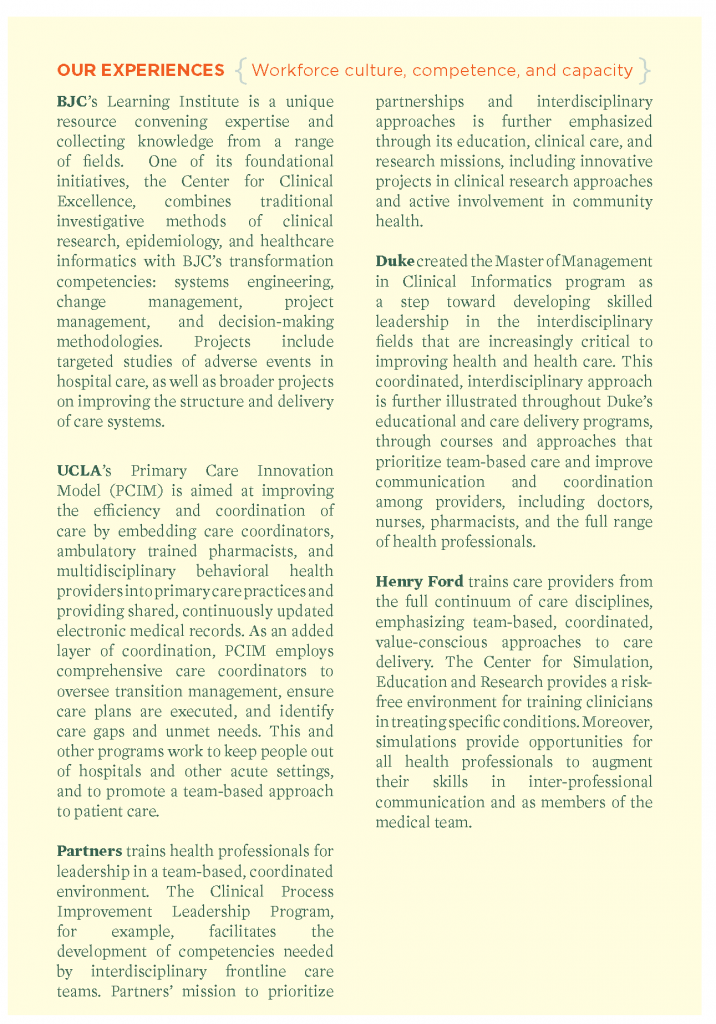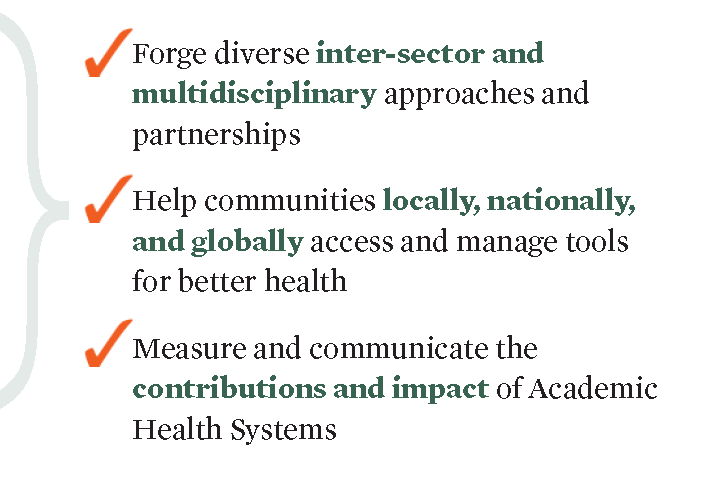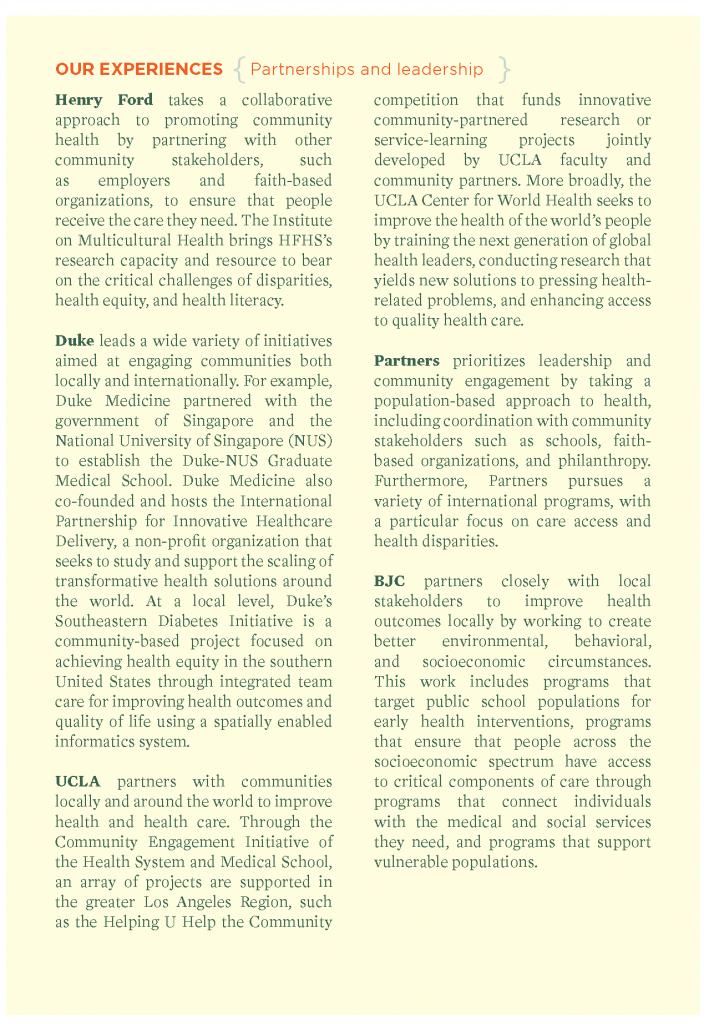Essential Stewardship Priorities for Academic Health Systems
In our leadership roles with Academic Health Systems, we are simultaneously excited by the stunning potential we see for health and health care and also sensitive to the strains that arise from the pace of changes underway in the organization, financing, and delivery of health care in America. It is critical that as the health system grapples with increasing pressures to improve outcomes and to lower costs, the capacities for innovation and building the workforce of the future are not lost. Given our unique mandates to foster progress in real-time, bench-to-bedside research while ensuring the excellence of the health workforce, we recognize that Academic Health Systems hold much of the responsibility for leading the way to a continuously learning and improving health system.
The fact that Academic Health Systems also face economic challenges that call into question the effectiveness and viability of current models might be a positive development. Experiences at our own institutions have made us acutely aware that these challenges provide the distinct opportunity for Academic Health Systems to adapt through differentiation and build upon our unique strengths by increasing collaboration and innovation so that we can fulfill our responsibilities to the health system and the country. From our experiences and what we have observed, we have identified the shared aspects central to our missions here as a list of essential stewardship priorities.
These 10 essential priorities serve as a grounding framework for Academic Health Systems in order to maintain our charge while establishing an ongoing capacity to ensure improved health through better care, innovation, and education. We offer examples of those experiences throughout the text and present full versions in the corresponding document on Academic Health System Case Material. But, we are also aware of many other examples throughout the nation and encourage the growth of this inventory through contributions by others.
Defining Challenges
As the recognized stewards of innovation and progress in research, education, and health care in the United States, Academic Health Systems (AHSs) hold primary responsibilities for ensuring that the next-generation health care workforce is equipped to use not only the skills, information, and resources available today but also those likely to be available tomorrow. With knowledge and tools in health and medicine changing at an accelerating pace, and with the organizational and practice patterns in health care in a period of dynamic and competitive flux, the challenges that confront all in health care today impinge acutely on the Academic Health System community. AHSs find themselves fixed in a crucible of expectations that they will deliver advanced expertise and performance, despite the context of circumstances that place them at the bleeding edge of revenue streams and traditions that are neither nimble nor easily adapted to changing financial circumstances.
A health system grappling with increasing pressures to improve quality while reducing costs depends on the tools of innovation and workforce effectiveness and efficiency to achieve the triple aim of better care, lower cost, and improved health outcomes. The onus of responsibility for development, validation, and standard-setting for key components often falls to AHSs, even as the funding and resources that support them dwindle. Stewarding these capacities is critical to the future of American health, and that function depends on the success and adaptability of Academic Health Systems.
Health care systems without these broader stewardship responsibilities have responded to cost pressures with a strategy of consolidation and efficiency initiatives, counteracting thinner margins by spreading fixed costs over a greater volume of activity and with acquisitions that diversify revenue streams to disperse financial risk over a larger population base. However, a longer-term, system-wide transformation to a better performing, coordinated health system requires the simultaneous engagement of innovation in the delivery of care, advancement of clinical research, and training and deploying a population health-conscious, team-based health care workforce.
Sustaining the ability of AHSs to contribute leadership in these arenas requires adapting to changing economic circumstances without sacrificing the unique capabilities that only AHS’s can contribute. Reports on the economic viability of Academic Health Systems make it clear that the status quo is no longer an option. A 2014 report from the Association of American Medical Colleges (AAMC) Advisory Panel on Health Care reviewed in detail the challenges to the sustainability of AHSs and identified eight elements for close consideration, which were generally as follows: systems orientation, geographically and clinically; governance strongly aligned with internal and external accountability; evolution in university relationships to enhance the capacity to respond to change; new organizational roles and skills for physician leaders; transparency in clinical outcomes and financial performance; restructuring the operating model for cost and quality; population health orientation and accountability; and candid ongoing assessment of strengths and weaknesses. [1]
Each of the AAMC report themes represents a practical management priority important to AHS operational and financial success moving forward. Our aim in this Institute of Medicine Discussion Paper is to provide a complementary emphasis on the dynamics that must be addressed on the mission side of AHS responsibilities, which are clearly central considerations for our business models. In this respect, we draw from our various experiences leading different Academic Health Systems to underscore 10 essential priorities, which are common to our missions and which must be kept squarely in focus as we contend with the turbulent times. Together, these priorities represent a strategy of adaptation through differentiation, tailored to the unique AHS responsibilities, needs, and resources. What will be critical to success in making the necessary changes is a willingness to develop meaningful partnerships, both with our stakeholders and with each other, as Academic Health System leaders working cooperatively toward shared goals.
Contributors to Health Progress
Academic Health Systems represent a critical and distinctive component of the nation’s health enterprise. Also known as Academic Medical Centers, AHSs represent partnerships between accredited higher education institutions, health professions schools, and health care providers. As both clinical and academic leaders, AHSs serve a critical role in the national dialogue on health and health care. They also hold responsibility for educating and training the future health workforce and often represent an essential link in the bench-to-bedside progression of clinical research. Many of the most transformational opportunities and innovations in the health system are focused on integration and coordination, from bridging research and practice to developing fluid data streams to enhancing resource use across different care sites in a community. Academic Health Systems therefore offer an ideal venue for research, development, and training around technologies and approaches that stand to benefit from interdisciplinary perspectives and a culture of learning and experimentation. Some of the ways in which AHSs hold unique and disproportionate societal responsibilities are highlighted below.
Delivery of complex services to high risk populations
The complexity of the patient population served by Academic Health Systems is well beyond that served elsewhere. AHSs tend to provide services that are less common and more specialized than in non-teaching hospitals, and they also disproportionately serve populations at higher risk. With respect to services, 87 percent of teaching hospitals provide psychiatric emergency services, compared to 25 percent for non-teaching hospitals. [2] Similarly, teaching hospitals provide 63 percent of our nation’s pediatric intensive care. [3] AHSs have traditionally played a critical role in community health and expanding access to care, and, in 2013, Academic Health Systems represented 6 percent of hospitals but provided 40 percent of the nation’s charity care and received 40 percent of transfers for complex care. [4]
Training the health and health care workforce
With health and health care comprising more than 17 percent of the national economy in the United States, the workforce needs in health and health care are substantial and dynamic. [5] The estimated current U.S. health workforce of nearly 12 million people extends well beyond the approximately 800,000 physicians, 2.7 million nurses, 300,000 pharmacists, 300,000 laboratory technicians, and other licensed health care professionals in active practice. [6,7,8,9,10] AHSs yearly graduate nearly 17,000 new physicians as well as about 20,000 nurses who graduate with bachelor’s degrees. [11,12] Approximately 5,000 pharmacists and 6,000 physician assistants also graduate annually, and some 110,000 medical residents are in training programs approved by the Accreditation Council for Graduate Medical Education. [13,14,15] Along with professional societies and the relevant government agencies, Academic Health Systems serve as the vehicles through which the health workforce pipeline needs are assessed and addressed.
Leadership in clinical practice and quality
AHSs are responsible not only for the numbers in the health professions pipeline but also for their skill sets and, again in partnership with professional societies and relevant government agencies, for adherence to training and practice standards. With the continuing focus on care outcomes and continuous improvement, the development of evidence-based clinical guidance continues to be an important tool for improving care quality. Currently, nearly 2,600 clinical guidelines are contained in the National Guidelines Clearinghouse maintained by the Agency for Healthcare Research and Quality. [16] AHSs are not as large as many mega multistate health systems and multi-specialty physician organizations, yet AHS clinicians serve disproportionately in key roles in the production of those guidelines as well as in their implementation and assessment. Academic Health Systems are also expected to serve as sources of counsel and, as appropriate, as test beds for demonstration and validation of new models and new approaches for the delivery and improvement of care processes.
Developing instruments of evaluation, accountability, and data management
Just as critical as their roles in developing new approaches and new models, faculty within Academic Health Systems are often sources of leadership in the assessment and measurement of care costs and outcomes. The drive across the health system toward improved outcomes and lower costs requires better metrics and better tools for assessing and improving in real-time as well as for identifying and communicating the return on investment of research activities. Of special importance in this respect is the expectation that AHSs will provide leading-edge expertise in the development and use of the digital infrastructure for care delivery, assessment, and improvement—a particular challenge since a sizable proportion of AHS patients are referrals from outside the system, requiring interfaces with multiple information technology (IT) platforms.
Biomedical and clinical research advancement and translation
Academic Health Systems are positioned to generate new knowledge and to discover new approaches to overall health improvement. With an estimated public and private investment totaling $120 billion in 2012, the U.S. remains the largest source of biomedical research in the world, and much of this work is conducted in Academic Health Systems. [17] Of the approximately $31 billion budget of the National Institutes of Health (NIH) in 2012, three-quarters went to AHSs. [18,19] The pharmaceutical and biotech industry invested nearly $70 billion in biomedical research in 2012, and although much of that was intramural research, a substantial share of the investment was shaped through professional interaction with members of the Academic Health System community. [20] AHSs continue to produce new insights about individual variation in disease susceptibility, diagnosis, and treatment. Perhaps the most rapidly emerging tool in biomedical and clinical research is found in the many forms of the developing digital infrastructure and the concomitant opportunities to draw lessons and knowledge from data sets of unprecedented size.
Fostering interdisciplinary perspectives and programs
One compelling research avenue for which Academic Health Systems are also uniquely positioned is that of interdisciplinary research. An important limiting factor of previous research activities has been the lack of capacity to assess the ways in which many factors—biological, social, environmental, and behavioral—intersect to affect disease occurrence and treatment. With the developments occurring now in biology and information technology, the capacity to study and understand those intersections is greater, but there are few places outside of the university and Academic Health System environments in which the necessary scientific disciplines can be assembled into teams to conduct this important work. As a result, Academic Health Systems currently offer the most promising venue for research, development, and training around technologies and approaches that stand to benefit from interdisciplinary perspectives and a culture of learning and experimentation.
Catalyzing attention to population health opportunities and priorities
A natural corollary of the advantageous capacity of AHSs for interdisciplinary study and practice is the growing need for them to serve as a source of leadership and guidance for population-wide health improvement efforts. In acknowledgment of both the potential and the necessity for population-based initiatives for health improvement, the Patient Protection and Affordable Care Act (ACA) contains a number of provisions to strengthen the national population health improvement agenda. As sources of expertise and data for population health, AHSs find themselves with new demands and opportunities for alliances and partnerships in the provision of health and health care programs that can meet the needs of diverse communities and the populations they serve.
Maintaining ties to global issues and perspective
Communication, commerce, and travel patterns have substantially changed perspectives, horizons, and interactions so that the need and the opportunity to share information and progress globally is becoming a practical reality. Historically, the academic health arena, through initiatives that are binational, multinational, and international in nature, has been the leading focal point for these relationships. Those links—particularly institution-to-institution collaborations—have increased substantially in the wake of new communication capabilities, and, although these communications are likely to become more diversified and networked, it is likely that many AHSs will still bear disproportionate responsibilities for action on the global scene to share best practices and improve care across the world.
The Changing Landscape
Along with overall forces for change at play in the American health system—consolidation and reform in the insurance market, concerns about escalating costs, incentives and practices around IT implementation, stronger focus on outcomes and accountability, requirements for transparency, and information available to consumers—Academic Health Systems are also facing changes in the revenue stream prospects related to support for health professions training and biomedical research. Highlights follow for some of the developments and trends with particular importance to the landscape for AHSs.
Nature of the care process
Whether economic, managerial, scientific, technical, or cultural, the care process is the common conduit for the influence of the various forces in play, and many of these forces can contribute positively to the evolution of the care process. Recognition and concern about substantial shortfalls in the efficiency and effectiveness of care, including in Academic Health Systems, creates pressures for change that can be difficult to accommodate from an institutional perspective. But, if the result is that patients are receiving more of the care they need and less of the care they do not and that what they receive is delivered more efficiently, then the result is in the patient’s interest. Increasingly, health systems are being challenged to develop models that shift care out of the hospital setting, moving the locus of care to the outpatient setting, the home, and the workplace where the emphasis can also shift to prevention, early detection, and longitudinal care management of chronic conditions. The special challenge for AHSs is moving the locus of its activities (care delivery, education, and research) without compromising either innovation or the need to provide care across the entire continuum. Similarly, the pressures for cost discipline and efficiency are coming at a time that coincides with the need to better understand and apply emerging scientific insights about opportunities for tailoring clinical interventions to individual patients and to responsibly introduce data from personal mobile sensors into diagnostic and decision processes. Relatedly, the care process is beginning to be altered by the growing culture around patient and family involvement, through developments such as patient care portals, decision aids, and access to Web-based information. Given their stewardship of the frontiers of health care, AHSs bear a special obligation to keep abreast of evolving opportunities and to help guide their appropriate assessment and use.
Role of patients and families
A number of developments are underway that may lead to fundamental change in the roles played by patients and families in health care. Access to scientific information in health and medicine is open to the public not only via availability and retrieval on websites but also via patient portals and mobile monitoring devices. Patients and families have ready access to sources of information important to their care. As patients and families become more fully and actively involved, their roles as fully functioning partners in the care team becomes more a reality, with substantial implications for the effectiveness of care.
Again, change of this potential magnitude offers opportunity and a mandate for AHSs to understand and lead the change process of predictive, personalized, and integrative health care models for patients and families.
Changing workforce needs and the prospect of reduced support for training
Greater dependence on information management technology to track, mobilize, and effectively apply the exploding body of scientific information; changes in the nature of the care process; and an emphasis on care teams all require adjustment in the culture and content of health professions training. The success and sustainability of coordinated care will require a balanced workforce. Opportunities for interprofessional education will be critical to building the capacity and competencies necessary for effective teamwork in the health care setting. Our “call for attention and action” is accentuated by the prospect of reduced support for training. Increasing scrutiny of and pressure to reduce Graduate Medical Education funding through the Medicare program increases the strain at a time when the number of medical schools has increased by about 15 percent. [21] The administration has proposed reducing GME support by about $11 billion over the coming 10 years. [22] The limitations are examined further in the recently released IOM report Graduate Medical Education That Meets the Nation’s Health Needs. [23] Outside of the clinical and direct patient care arena is the considerable need for more informaticians. Both the Office of the National Coordinator for Health Information Technology and the Bureau of Labor Statistics are predicting substantial shortages—between 35,000 and 50,000 people by 2020—in the supply of health information managers. [24] Although few would question the need for a studied assessment of the health workforce needs—profiles, skill sets, and strategies—creativity will clearly be important in the years ahead, and some AHSs may be able to get ahead of the curve by expanding their focus beyond physician education to create more interdisciplinary programs with other health professionals in growing areas such as population health management and clinical informatics. [25]
Biomedical research funding
Acute challenges to the core activities of many Academic Health Systems derive from the prospect of reduced funding for biomedical research. Currently, the revenue supporting AHSs comes from several key sources: Medicare, 21 percent; Medicaid, 17 percent; commercial insurers, 33 percent; and grants and contracts, 12 percent; with various other sources making up the balance. [26] Of these, the only category expected to shift dramatically is the share coming from grants and contracts, with a projected decline of nearly 25 percent between 2010 and 2020. [27] This reflects projections based on the nearly 22 percent decline in purchasing power from 2003 to 2012 as a result of NIH expenditures on biomedical research remaining essentially flat in the face of recession and inflation. [28] As a direct corollary, the NIH study section scores required for funding grant applications have tightened substantially, which has, in particular, placed younger investigators at a disadvantage. [29] AHSs will need to forge partnerships with each other and with those holding private-sector research resources. New research capacities and funding streams can take advantage of patient care and related data systems as tools in developing novel and accelerated clinical research and knowledge translation strategies.
Transparency, accountability, and value
Throughout health care, there is a strong and growing emphasis on the importance of—and need for—transparency, accountability and better outcomes in health care. Because the health system as a whole has been relatively opaque in its processes—not to mention its costs—external pressures now demand the inevitable movement toward increased transparency for collecting and reporting outcomes data. Academic Health Systems should be well-positioned to provide the model for performance reporting, equipped as they are both with the analytic capability and with the foundational philosophical commitment to openness and truth that represent the basis for the establishment of the universities with which most are identified.
Health sector consolidation
The dominant strategy for health systems seeking financial security under changing circumstances has been acquisition and consolidation, forming bigger, more inclusive care delivery and population health management systems. Academic Health Systems require a more nuanced approach to adaptation that balances the efficient delivery of care against the responsibility to support clinical research and educate the next generation of clinicians. The pace of AHS consolidation is accelerating, and the pressures for expansion and scale through merger and/or acquisition are undeniable. The report of the AAMC Advisory Panel on Health Care concluded that AHSs have four options: form a system, partner with others in a collaborative network, merge into a system, or shrink in isolation. [30] In recent years, many AHSs have expanded their clinical faculty and expertise in clinical care and health services delivery in order to better leverage their size, unique services, and market prominence. Still uncertain are the implications of these dynamics for the unique AHS stewardship roles for teaching, research, and care innovation.
Care Innovation and Values
The primary aim of health systems is to provide the highest quality care to their patients and the public. The economic, scientific, and cultural climate requires health systems to reassess and improve their performance. Ensuring patient-centeredness must be central to the redesign of care delivery. Partnership with patients, families and the public provides the medical team with unique insight into the care experience, thereby increasing the quality of the care experience and providing a model for continuous learning and improvement. Equally important is the push to extend care beyond the hospital and to develop innovative models for systems that treat the public on a population and global scale.
Patient Engagement
Patient-centeredness as an essential element of better health and better health care has been at the top of the health policy agenda since the 1999 IOM report To Err is Human, and while meaningful change is not yet apparent, a number of developments have the potential for a paradigm shift. [31] This is not simply because of the ethical notion that patients have a right to more informed involvement in their care, but also because that involvement leads to better outcomes and because ensuring continuous learning from the care experience depends on engagement from patients, families, and the public. Health care must be aligned with the needs and expectations of the people it serves. Advances in technology have increased the capacity and, just as critically, patient expectations for technologically fluid communication and interaction with the health system. Key steps toward enabling engagement include implementing patient portals, decision aids, and m-health, and promoting research participation and advisory council activities. The substantial change required in culture and practice will be unnecessarily delayed unless Academic Health Systems model, teach, and study what is needed.
Personal and population health management
AHSs often draw patients from a broad and wide geography representing multiple sources of referral and settings of care delivery. This requires more upstream and downstream relationships with other care providers, including family caregivers, and is a priority not only for the conduct of the care needed but also for modeling appropriate professional communication and care coordination for AHS trainees. Philosophically, this requires AHSs to think more in terms of improving health beyond a specific episode of illness or injury rather than simply providing health care to remedy the current ailment. Furthermore, the focus on population health should reduce inappropriate medical utilization and optimize resource use.
Frontiers of Biomedical Science
Health systems hold an obligation to put to use the vast amount of knowledge generated and data collected concerning health. Developing an infrastructure and workforce capacity to collect and analyze data helps create the culture of continuous learning and faster translation of research into practice. With the abundance of information now available, priority setting and engaging partners in research streamline the bench-to-bedside time frame while helping to guarantee that the research done is high quality and meaningful to patients and the public.
Leverage data science and resources
At the heart of the philosophy and practice of continuous learning in health care is the ability to take advantage of important advances in information technology to bring research and practice closer together—to generate new knowledge from the care experience. As leaders in care, in research design, and in biostatistics and informatics, Academic Health Systems are uniquely positioned to use their clinical, management, and research data capacities to advance a robust, interdisciplinary, outcomes-oriented research enterprise. By leveraging data resources and finding opportunities for academic collaboration, Academic Health Systems can become centers of research not only for the development of new clinical therapies and approaches but also for optimizing the delivery of care and engaging the full range of stakeholders in health.
Sharpen focus and pace
Since the Flexner report of 1910, which led to the re-engineering of medical education around a central focus on a systematic assessment and application of the evidence base, and, in particular, over the past half century of emphasis on the conduct of clinical trials to evaluate proposed interventions, teaching health institutions have emerged as key stewards of the frontiers of biomedical science. [32] In addition to the development of new knowledge, Academic Health Systems have a responsibility to engage stakeholders across the health sector to ensure that evidence is thoughtfully developed and applied to practice. Community-engaged and patient-centered research empowers patients and other stakeholders to be active partners in setting research priorities, formulating research questions, evaluating study design and intermediate results, participating in research studies, and facilitating dissemination and uptake of the research findings. Achieving a true partnership with the community strengthens the value of AHS efforts to improve health outcomes.
Workforce Culture, Competence, and Capacity
The success of the transformation to better care at lower cost will depend on the next generation of the health workforce. The growing complexity of care requires a diversity of perspectives and strong collaboration across health professions. Incorporating lessons and partnerships across disciplines helps to prepare for the new models of care delivery. Frontline clinicians are the natural leaders to promote and populate these new interdisciplinary teams.
Continuously learning culture
Academic Health Systems bring together research, education, and clinical care in a single institution. As such, they are uniquely positioned to realize the benefits of continuous learning, both internally and externally. Developing programs and practices that enable real-time learning at every level and across missions will enable Academic Health Systems to unlock efficiencies through innovation and to take a leadership role in promoting a more open, coordinated, and evidence-based health system.
Inter-professional, team based workforce
The next-generation health care workforce will face a range of new challenges, as the health system shifts toward a more disciplined approach to process improvement through adherence to standards and guidelines, a keen emphasis on outcomes measurement and comparisons of outcomes variation, and, undoubtedly, continued pressure to reduce the cost of the health care enterprise. Preparing clinicians, as well as specialists in emerging health fields like health informatics and systems management will be critical to the success of new, more efficient models of care. This shift will require not only new skills and capabilities but also a new culture of work for the health system. While independence, singularity, and autonomy have long been valued among health care providers, consequential shortfalls have occurred in net effectiveness and efficiency in care. The advantages of a team approach to the care process include improvements in workforce productivity, better coordination of care processes and fewer lapses in handoffs, and better results.
Clinical leadership
For new models of care to be implemented, clinical leaders must be developed to lead and manage the change. Academic Health Systems must create an environment that supports developing the health leaders of tomorrow. The focus of Academic Health Systems should be on fostering an ecosystem to develop and empower clinician leaders, an ecosystem not simply implementing traditional leadership programs but rather a novel approach that gives trainees and faculty members an experiential learning opportunity focused on real-world applications of how to manage change at scale. Most clinicians know only their own specialty area of practice, the characteristics of one type of patient in one specific hospital or in one specific market. Populations are far more diverse, however, as is the complexity of our nation’s health care system.
Partnerships and leadership
Health systems can no longer function in silos. Rapid generation of knowledge juxtaposed with dwindling access to necessary resources and funds has created too heavy a burden for one institution to manage successfully in isolation. Fortunately, significant opportunities exist for partnerships with other sectors and disciplines within institutions as well as within the communities these systems serve. Equally important in this environment will be carefully measuring and communicating the benefit and successes of Academic Health Systems.
Inter-sector and multidisciplinary
The longstanding tradition of a high level of independence in department-based leadership and decentralized control of human assets (faculty and physicians), financial assets (reserves and endowments), and physical assets (space and equipment) in Academic Health Systems can make this a particularly difficult challenge, especially when the rewards and recognitions no longer emanate from individual achievement, but rather from achieving coordination and efficiency in the delivery of care, as well as in the conduct of research and education. Thus, AHSs should lead in the development of new care models that emphasize accountable care, care coordination, resource utilization, and health improvement. Inter-departmental and multidisciplinary partnerships are essential. In addition, the financial constraints that come with shrinking NIH research support compel the AHS community to look to alliances with the commercial community for the sponsorship of research on clinical interventions. Emerging recognition of the multifactorial nature of disease processes and treatments compels the engagement of partner investigators across disciplines and institutions.
Locally, nationally, and globally
Academic Health Systems serve people and communities at multiple levels. Not only do they hold responsibility for protecting and promoting the health of their local citizenry through clinical and community health services, their cross-cutting expertise and relationships provide an advantage in linking with community, national, and international health stakeholders. They can and do serve as conduits for ideas among different models of care and approaches to health locally and across the world, often making critical links between fundamental health progress and progress in other sectors.
Contributions and impact
At a time of such flux in the nature of the various support bases for Academic Health Systems, careful assessment and communication of the centrality of their mission, activities, and contributions is vital. AHSs are counted among the most respected institutions in the U.S. health system, with a reputation for attracting the most talented and innovative clinicians, providing highly specialized services, and sponsoring cutting edge research that brings new therapies and new approaches to the delivery of care across the nation. AHSs need to demonstrate and communicate clearly how they add unique value individually and collectively.
Moving Forward
As centers of convergence for health care, biomedical research, and workforce training, Academic Health Systems are critical drivers of innovation and are uniquely positioned to lead the health system toward a new standard of care delivery. As such, the leaders of Academic Health Systems have the responsibility to manage economic realities while working in partnership with each other to develop the future health workforce, find innovative solutions to critical challenges, and unlock the benefits of a bench-to-bedside continuous learning health system. We hold many advantages, but to succeed in meeting the full potentials and obligations of our stewardship responsibilities, we will need to do better in assessing, developing, and organizing shared strategies across the AHS community, forging partnerships with stakeholders from related sectors, making the case for our unique contributions, and establishing the ongoing capacity to assess our progress.
Adaptation of shared strategies across the AHS community.
The 10 priorities discussed here represent the compelling opportunities for Academic Health Systems to adapt to changing economic circumstances without losing sight of the contributions and capacities that matter most for the future of America’s health system. While each Academic Health System has its own priorities and unique characteristics, they are united by a shared role and responsibility to the health system as a whole, and, as such, can and should work together to align priorities and pursue new opportunities for efficiency and effectiveness.
Forging partnerships across sectors.
Just as critical to success are partnerships with key community, research, and education stakeholders. The research and education activities of Academic Health Systems benefit the American health enterprise as a whole, and as such, a wide variety of stakeholders at the local, national, and international level have shared interests and priorities. As research funding from the National Institutes of Health declines, AHSs not only must work to partner with philanthropic organizations, employers, payers, and other stakeholders who share an interest in the value generated by our work, but we must also seek new, innovative partnerships with the information technology sector for novel approaches with the prospect of redesigning the clinical research paradigm.
Making the case.
As the stewards of national progress in care innovation, health professions training, and the biomedical research frontiers, Academic Health Systems are unique contributors on the national scene. But we cannot assume that the nature and magnitude of our contributions will be readily apparent to the general public, to policymakers, or even to our direct stakeholders. It is essential that we work, collectively and individually, to assess and characterize the qualitative and quantitative realities of the many facets of our impact—past, present, and future.
Monitoring results and progress.
Finally, measuring and evaluating progress across each priority will be critical to ensuring that Academic Health Systems adapt swiftly and effectively to the changing national landscape of health. As pilot programs and care models aimed at efficiency and coordination continue to develop, the capacity to distinguish between success and failure and to communicate those results quickly could be the difference between a health system that learns to manage new realities and one that falls behind. A new culture of care built on continuous learning and improvement—and the tools necessary to support it—can enable rapid progress in quality and efficiency, and ensure that Academic Health Systems continue to grow their legacy of innovation and leadership.
References
- Enders, T. and J. Conroy. 2014. Advancing the Academic Health System for the future: A report from the AAMC Advisory Panel on Health Care. Washington, DC: Association of American Medical Colleges.
- AAMC (Association of American Medical Colleges). 2013. Patient care at AAMC-member teaching hospitals. Available at: http://www.aamc.org/ (accessed August 1, 2014).
- AAMC (Association of American Medical Colleges). 2013. Patient care at AAMC-member teaching hospitals. Available at: http://www.aamc.org/ (accessed August 1, 2014).
- AAMC (Association of American Medical Colleges). 2013. Patient care at AAMC-member teaching hospitals. Available at: http://www.aamc.org/ (accessed August 1, 2014).
- CMS (Centers for Medicare & Medicaid Services). 2012. National health expenditures 2012 highlights. Available at: http://www.cms.gov/Research-Statistics-Data-and-Systems/Statistics-Trends-andReports/NationalHealthExpendData/downloads/highlights.pdf (accessed June 13, 2014).
- KFF (Kaiser Family Foundation). 2012. Total health care employment. Available at: http://kff.org/other/state-indicator/total-health-care-employment/ (accessed June 19, 2014).
- KFF. 2012. Total professionally active physicians. Available at: http://kff.org/other/state-indicator/total-active-physicians/ (accessed June 19, 2014).
- KFF. 2012. Total employed registered nurses. Available at: http://kff.org/other/state-indicator/totalregistered-nurses/ (accessed June 19, 2014).
- BLS (Bureau of Labor Statistics). 2012. Occupational outlook handbook. Available at: http://www.bls.gov/ooh/healthcare/pharmacists.htm (accessed June 19, 2014).
- BLS. 2012. Occupational outlook handbook. Available at: http://www.bls.gov/ooh/healthcare/medical-and-clinical-laboratory-technologists-and-technicians.htm (accessed June 19, 2014).
- PricewaterhouseCoopers Health Research Institute. 2012. The future of the academic medical center: Strategies to avoid a margin meltdown. Available at: http://healthsciences.utah.edu/hcr/2012/resources/the-future-of-academic-medical-centers.pdf (accessed June 13, 2014).
- AACN (American Association of Colleges of Nursing). 2013. 2013 AACN annual survey results.
- AACP (Academic Association of Colleges of Pharmacy). 2014. Academic pharmacy’s vital statistics. Available at: http://www.aacp.org/about/pages/vitalstats.aspx (accessed June 13, 2014).
- Hooker, R., J. Cawley, and C. Everett. 2011. Predictive modeling the physician assistant supply: 2010–2025. Public Health Reports 126: 711. Available at: http://www.publichealthreports.org/issueopen.cfm?articleID=2714 (accessed June 13, 2014).
- AAMC. 2013. Increasing the number of physicians critical to workforce planning. Available at: https://www.aamc.org/newsroom/newsreleases/360008/20131105.html (accessed August 1, 2014).
- AHRQ (Agency for Healthcare Research and Quality). 2014. Guideline index. Available at: http://www.guideline.gov/browse/index.aspx?alpha=A (accessed June 13, 2014).
- Chakma, J., G. H. Sun, J. D. Steinberg, M. Sammut and R. Jagsi. 2014. Asia’s ascent – global trends in biomedical R&D expenditures. New England Journal of Medicine 370(1):3-6. https://doi.org/10.1056/NEJMp1311068
- NIH (National Institutes of Health). 2012. President’s proposed 2012 NIH budget. Available at: http://www.nih.gov/about/director/budgetrequest/NIH_BIB_020911.pdf (accessed on August 1, 2014).
- NIH. 2013. NIH awards by location & organization. Available at: http://report.nih.gov/award/index.cfm?ot=DH,27,47,4,52,64,10000,MS,20,16,6,13,10,49,53,86,OTHDH&fy=2012&state=&ic=&fm=&orgid=&
distr=&rfa=&om=n&pid= (accessed June 13, 2014). - Chakma et al., op. cit.
- ACS (American College of Surgeons). 2012. Critical state of GME funding. Available at: http://bulletin.facs.org/2012/11/critical-state-of-gme-funding/ (accessed on August 1, 2014).
- ACS (American College of Surgeons). 2012. Critical state of GME funding. Available at: http://bulletin.facs.org/2012/11/critical-state-of-gme-funding/ (accessed on August 1, 2014).
- Institute of Medicine. 2014. Graduate Medical Education That Meets the Nation’s Health Needs. Washington, DC: The National Academies Press. https://doi.org/10.17226/18754.
- NORC at the University of Chicago. 2014. Evaluation of the information technology professionals in health care (“workforce”) program – summative report. Available at: http://www.healthit.gov/sites/ default/files/workforceevaluationsummativereport.pdf (accessed on August 1, 2014).
- NORC at the University of Chicago. 2014. Evaluation of the information technology professionals in health care (“workforce”) program – summative report. Available at: http://www.healthit.gov/sites/ default/files/workforceevaluationsummativereport.pdf (accessed on August 1, 2014).
- PriceWaterhouseCoopers, op. cit.
- PriceWaterhouseCoopers, op. cit.
- amfAR (The Foundation for AIDS Research), TAG (Treatment Action Group). 2013. The costs of flat funding for biomedical research. Available at: http://www.amfar.org/uploadedFiles/_amfarorg/ On_the_Hill/Issue%20Brief%20-%20The%20Costs%20of%20Flat%20Funding%20NIH%20 Research_080513.pdf (accessed June 13, 2014).
- amfAR (The Foundation for AIDS Research), TAG (Treatment Action Group). 2013. The costs of flat funding for biomedical research. Available at: http://www.amfar.org/uploadedFiles/_amfarorg/ On_the_Hill/Issue%20Brief%20-%20The%20Costs%20of%20Flat%20Funding%20NIH%20 Research_080513.pdf (accessed June 13, 2014).
- Enders, et al., op. cit.
- Institute of Medicine. 2000. To Err Is Human: Building a Safer Health System. Washington, DC: The National Academies Press. https://doi.org/10.17226/9728.
- Duffy, T. P. 2011. The Flexner Report – 100 years later. Yale Journal of Biological Medicine (84)3: 269-276. Available at: http://www.ncbi.nlm.nih.gov/pmc/articles/PMC3178858/ (accessed August 1, 2014).

